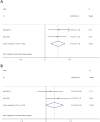The effectiveness of virtual reality in people with osteoporosis or osteopenia: a systematic review and meta-analysis of randomized controlled trials
- PMID: 40671710
- PMCID: PMC12263551
- DOI: 10.3389/fphys.2025.1612882
The effectiveness of virtual reality in people with osteoporosis or osteopenia: a systematic review and meta-analysis of randomized controlled trials
Abstract
Background: Osteoporosis is a global bone disease, and drug therapy carries the risk of side effects, requiring exploration of safe and effective alternative therapies. Virtual reality (VR) has shown potential in rehabilitation medicine, but its efficacy in the management of osteoporosis and osteopenia has not been systematically evaluated.
Method: Using PubMed, Embase, the Cochrane Library, and Web of Science, we conducted a comprehensive database search to identify randomized controlled trials (RCTs) investigating the effects of VR on osteoporosis and bone loss. Trials published up to 30 March 2025 met our predefined inclusion and exclusion criteria. We extracted data, reviewed the literature. We assessed the methodological quality of the included trials and the certainty of the pooled evidence. Meta-analyses were performed using StataSE version 16.
Results: Our meta-analysis included 216 patients from 5 RCTs. All cases included in our study adopted the non-immersive VR intervention approach. Femoral neck bone mineral density (BMD) (standardized mean difference [SMD] = 0.77, 95% confidence interval [CI] = 0.35-1.19, P < 0.0001, I2 = 0%), balance (SMD = 2.58, 95% CI = 1.10-4.05, P = 0.001, I2 = 91.2%) and mobility (SMD = 1.63, 95% CI = 0.14-3.13, P = 0.032, I2 = 93.7%) were improved compared to the control group. However, lumbar BMD (SMD = 0.39, 95% CI: -0.02, 0.80, P = 0.062, I2 = 0%) and quality of life (QOL) (SMD = 2.50, 95% CI: -2.15, 7.16, P = 0.292, I2 = 97.4%) were not significantly improved compared to the control group. None of the included studies reported adverse events or safety data.
Conclusion: This systematic evaluation provides valuable evidence for the management of osteoporosis and osteopenia through VR. However, given the overall low and very low level of evidence, the results need to be treated with caution. In the future, VR may be a potential treatment for osteoporosis and osteopenia.
Systematic review registration: https://www.crd.york.ac.uk/PROSPERO/view/CRD420251023178, PROSPERO, identifier CRD420251023178.
Keywords: aging; exercise; osteopenia; osteoporosis; virtual reality.
Copyright © 2025 He, Dong, Lin, Wang, Diao and Gao.
Conflict of interest statement
The authors declare that the research was conducted in the absence of any commercial or financial relationships that could be construed as a potential conflict of interest.
Figures





Similar articles
-
Non-pharmacological management of infant and young child procedural pain.Cochrane Database Syst Rev. 2023 Jun 14;6(6):CD006275. doi: 10.1002/14651858.CD006275.pub4. Cochrane Database Syst Rev. 2023. PMID: 37314064 Free PMC article.
-
Parathyroidectomy for adults with primary hyperparathyroidism.Cochrane Database Syst Rev. 2023 Mar 8;3(3):CD013035. doi: 10.1002/14651858.CD013035.pub2. Cochrane Database Syst Rev. 2023. PMID: 36883976 Free PMC article.
-
Music interventions for improving psychological and physical outcomes in people with cancer.Cochrane Database Syst Rev. 2021 Oct 12;10(10):CD006911. doi: 10.1002/14651858.CD006911.pub4. Cochrane Database Syst Rev. 2021. PMID: 34637527 Free PMC article.
-
Systemic pharmacological treatments for chronic plaque psoriasis: a network meta-analysis.Cochrane Database Syst Rev. 2017 Dec 22;12(12):CD011535. doi: 10.1002/14651858.CD011535.pub2. Cochrane Database Syst Rev. 2017. Update in: Cochrane Database Syst Rev. 2020 Jan 9;1:CD011535. doi: 10.1002/14651858.CD011535.pub3. PMID: 29271481 Free PMC article. Updated.
-
Systemic pharmacological treatments for chronic plaque psoriasis: a network meta-analysis.Cochrane Database Syst Rev. 2021 Apr 19;4(4):CD011535. doi: 10.1002/14651858.CD011535.pub4. Cochrane Database Syst Rev. 2021. Update in: Cochrane Database Syst Rev. 2022 May 23;5:CD011535. doi: 10.1002/14651858.CD011535.pub5. PMID: 33871055 Free PMC article. Updated.
References
Publication types
LinkOut - more resources
Full Text Sources
Miscellaneous

